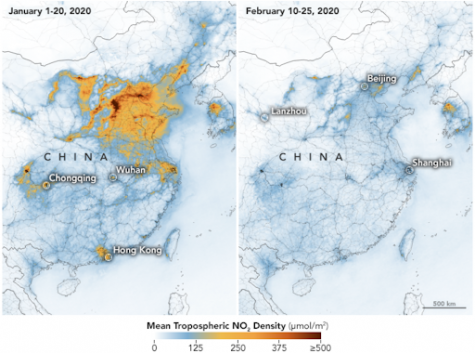The COVID-19 Pandemic: A Gift to the Environment or a Precursor to Environmental Devastation?

The Himalayas have become visible in parts of India for the first time.
May 10, 2020
The historically mucky canal waters of Venice have cleared up to uncover majestic jellyfish swarms. The Himalayas have become visible in parts of India for the first time. And man-made landmarks like the Hollywood sign in Los Angeles and the Manhattan skyline are now visible and unobscured by smog.
With entire populations across the globe ordered to stay home, offices are deserted, schools are vacant, vehicle traffic is significantly reduced, and airline schedules are cut by 60-90%. These changes, which have directly and indirectly helped to improve the environment, are a direct result of the restrictive measures put in place to contain the rapidly spreading novel coronavirus (COVID-19).
I want to preface by clarifying that in no way should a global pandemic claiming people’s lives be considered an exemplary way to bring positive environmental change. Instead, these changes should offer a glimpse of how we can combat the environmental devastation of our planet in the future.

The historically mucky canal waters of Venice have cleared up to uncover majestic jellyfish swarms.
Positive Impacts: Reduced Greenhouse Gas Emissions, Improvements in Air Quality, and Reduction in Seismic Vibrations
Due to the wide spread halt of the economy and the subsequent reductions in vehicle traffic, Greenhouse gasses have reached an all time low. Researchers at Columbia University observed that emissions of carbon monoxide over New York City have declined more than 50% below average levels for this time of year.
Across the globe in China, NASA and the European Space Agency (ESA) have witnessed airborne nitrogen dioxide (NO2) emissions plummet to an all-time low.

Tropospheric NO2 Column, March 2015-2019 Average, Northeast USA NASA
The maps above highlight the concentrations of nitrogen dioxide across China from January 1-20, 2020, (before the quarantine) to February 10-25 (during the quarantine). The drop, though unprecedented, is substantial. China, known to be one of the world’s worst offenders in harboring air pollutants, has decreased its industrial output significantly. As a result, in Wuhan, soot levels have dropped by 44%.
Not only is reduced air pollution an effect of the coronavirus lockdown, but a nationwide study conducted by Harvard University found that the COVID-19 death rate was higher for patients who were exposed to elevated concentrations of air pollution.
A decreased demand for oil could also dampen emissions. The International Energy Agency predicts “global oil demand to fall in 2020-the first full-year decline in more than a decade.”
Thomas Lecocq, a geologist and seismologist at the Royal Observatory in Belgium, observed that Brussels has experienced an approximate 30% to 50% reduction in ambient seismic noise since mid-March, around the same time stay-at-home measures were put in place. This reduction would allow scientists to detect minute vibrations previously unregistered by many seismic stations.
Negative Impacts: Build up of Medical and Organic Waste, and Damage to Certain Ecosystems
Not all the environmental effects of this pandemic are positive. As the use of protective gear has increased, substances including face masks, plastic gloves, bags, and tissues have been irresponsibly disposed of in public spaces. This raises concern not only because it is an act of littering, but because this potentially contaminated waste poses major health risks.
Certain food retailers have also pulled back their plastic bag restrictions out of fear that reusable bags could further the spread of the Virus.
Ecosystems that rely on human monitoring may also face serious repercussions. In the agricultural and fishing industry, reduced exports could lead to the build up of organic waste.
In fact, if the crisis continues, Robert Hamwey from the United Nations Conference on Trade and Development (UNCTAD) believes that “many will be forced to abandon existing sustainable production in order to generate income quickly in domestic markets, potentially resulting in further poverty and overexploitation of natural resources and ecosystems.”
Temporary or Long-Lasting?
It is unlikely that the positive impacts brought about by the COVID-19 pandemic will culminate in a healthy and long-lasting change to the environment.
Research indicates that a drastic increase in economic activity may occur as the world attempts to compensate for the loss of revenue during the time. Past models seem to agree with this statement; after the recession 2008, a similar rebound occurred. However, this could spark a major upsurge in harmful greenhouse gas emissions.

